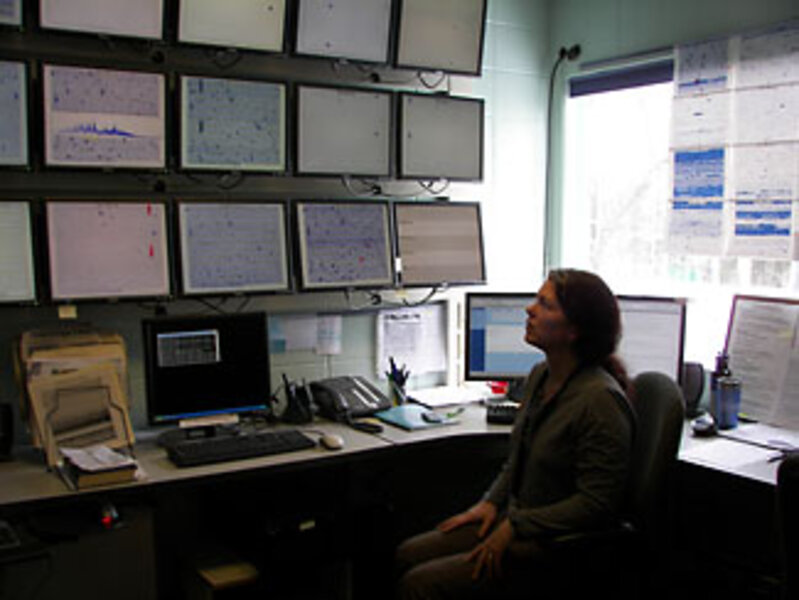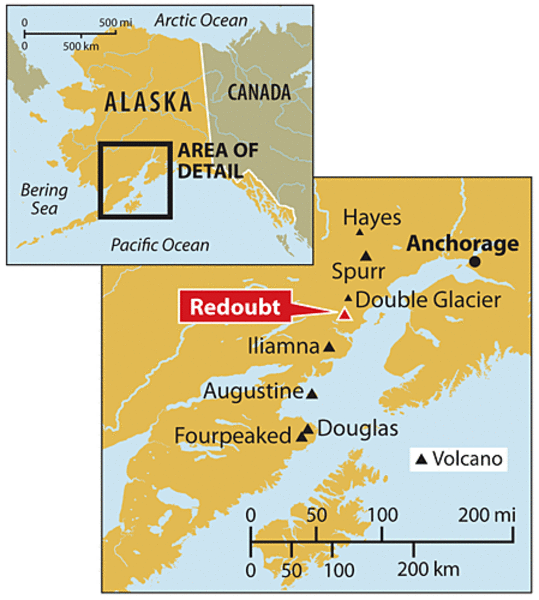When Mt. Redoubt erupts, these scientists are on the job
Loading...
| Anchorage, Alaska
Deep in the recesses of a low-slung, cinder-block building, scientists are working around the clock to keep pace with the volcano that for weeks has wreaked havoc on air travel, oil production, and air quality.
The scientists at the Alaska Volcano Observatory (AVO) have been on high alert since mid-January, when Mt. Redoubt started rumbling. On March 22, the 10,197-foot-tall volcano exploded with an ash cloud that spewed nearly 10 miles into the air. Since then, it has erupted about 20 times, belching plumes of gritty ash and steam and showers of rocks, and triggering vast mudslides from quick-thawed ice and snow.
Within the AVO's operations room, two banks of computer screens on the wall display seismic and meteorological data, which the scientists use to forecast future explosions and ash-fall patterns. Real-time computer images stream in from remote cameras posted on the mountain. Taped to the window are computer printouts of seismic recordings: Low-level "drumbeat" earthquakes are indicated by shaky lines; big eruptions are marked by dark blue spots where the seismic needle jerked violently. Scientists field calls from colleagues around the world, from government officials, from reporters seeking to gauge conditions, and, sometimes, from the general public.
"I got a call the other day: 'Someone was running into [a] bar and just said Redoubt exploded again!' " said AVO geologist Kate Bull.
Between explosions, scientists who work at the observatory – partly housed in a former college dorm on the tree-lined campus of Alaska Pacific University here – have been ferried via plane or helicopter to the volcano itself, to bring back ash and pumice samples for laboratory analysis, check conditions firsthand, and, if necessary, repair eruption-damaged sensors.
Overexcited bar chatter aside, the AVO's methodical work is serious business for Alaska. "Our job is to understand and warn of volcanic hazards in the state of Alaska," says John Power, a geophysicist.
People here didn't take it too kindly, therefore, when "volcano monitoring" became a political punch line in a televised speech by Louisiana Gov. Bobby Jindal. In it, the Republican governor disparaged the work of the AVO and sister agencies as unworthy of federal stimulus funding. "Instead of monitoring volcanoes, what Congress should be monitoring is the eruption of spending in Washington, D.C.," the governor said Feb. 24.
AVO scientists have been reluctant to comment publicly on the subsequent kerfuffle, but their boss has not.
"This is an indicator and proof of the importance of earth science to the United States of America...," Interior Secretary Ken Salazar declared in a telephone news conference on the day after Redoubt blew. "Through the work of the USGS [US Geological Survey] and being able to monitor what was happening with the volcano ... hopefully, we will be able to prevent the endangerment of people and places...."
Alaska politicians also punched back at Governor Jindal. The state's two US senators are backing a bill that seeks not only more funding for volcano monitoring, but also an expanded system of observatories beyond the existing network in Alaska, Hawaii, California, the Cascade Range, and Yellowstone National Park. [Editor's note: The original version left out one of the locations in the network.]
Certainly, Alaskans are at no risk of suffering the fate of ancient Pompeii: Only one eruption-related fatality is on record here. But eruptions from some 40 active volcanoes here are no mere curiosities.
Redoubt's last eruptive cycle – a series of explosions, mudslides, and ash clouds that lasted from December 1989 to April 1990 – proved to be a costly event in terms of property damage. The toll was estimated at $160 million, second only to the economic damages wreaked by the 1980 eruption of Mt. St. Helens in Washington State.
It could have been far worse. Redoubt nearly downed a jetliner flying through Alaskan airspace. The KLM jet sucked ash into all four engines, which abruptly quit, sending the jet into a two-mile dive. Just short of hitting the ground, the pilots managed to restart the engines and land safely in Anchorage, despite having to peer through a windshield that was heavily sandblasted by the rough ash.
Redoubt is one of four Alaska volcanoes to have erupted in the past year. In all, Alaska has about one-tenth of the world's active volcanoes. As a consequence, the AVO, which has satellite offices in Fairbanks, holds a high profile in the world of earth sciences. Many volcano experts are alumni of the AVO or, like Mr. Power, of the affiliated University of Alaska-Fairbanks.
The AVO, a cooperative venture of the USGS, state Division of Geological and Geophysical Surveys, and University of Alaska Fairbanks' Geophysical Institute, was founded in 1988, two years after the eruption of Augustine Volcano, a restless peak that forms its own island in Cook Inlet. It now maintains sensors, cameras, and measuring devices on many volcanoes, though some, like Cleveland Volcano in the Aleutians, are so remote that they can be monitored only by aircraft, radar, and occasional passing ships.
The AVO's 2008 budget was about $7.5 million, of which some $2.6 million came from the Federal Aviation Administration, according to Tom Murray, the scientist in charge at the AVO. In addition, the organization will receive about $7 million in federal stimulus funds, Sen. Mark Begich (D) of Alaska announced Friday.
The AVO staff numbers 66, plus graduate students. But during this 24/7 period, it has pulled in scientists from other volcano observatories in the US to help out.
The AVO provides warnings and forecasts to the Federal Aviation Administration and other aviation organizations about conditions in the skies over Alaska. Four volcanoes lie near Anchorage and its airport, the world's third-busiest air-cargo handler.
"Any airplane that takes off from the continental United States and flies to Asia flies right over the Alaska Aleutian volcanoes," says Power.
Alaska's volcanoes pose little direct threat to lives of people on the ground, but there have been close calls. A flank collapse at Augustine Volcano in 1883 caused what is believed to have been a local tsunami that hit a nearby Native village. Two US Fish and Wildlife Service biologists had to be rescued last summer from a shaking Kasatochi Island while that volcano was tossing chunks of rocks into the air. The only likely fatality from an Alaska volcano came during World War II, when a soldier disappeared on the Aleutian island that holds Cleveland Volcano, Power says. The soldier's fate has never been determined with certainty, he says.
While AVO scientists strive to provide forecasts and warnings, they are also working to piece together Alaska's geologic story. As Redoubt erupts, the scientists have been studying its sulfur-dioxide and carbon-dioxide emissions.
Close-up examinations of emitted material are the job of geologist Kristi Wallace, a self-described "tephra queen." In the AVO's tephra laboratory, the burned smell of sulfur permeates, and Ms. Wallace sorts through samples of ash and newly formed "juvenile" rock collected from Redoubt. She is intrigued by ice crystals within the ash expelled during this cycle's early eruptions. They reveal something about the volcano's characteristics, but Wallace is struggling to keep the ice-laden samples intact so that she can figure out exactly what.
"I just brought some home and put them in the freezer, next to all the salmon," she says.
For all the troubles they cause, Alaska's smoldering volcanoes offer some potential benefits – namely, nonpolluting energy. The state last year auctioned off geothermal leases at Mt. Spurr, a volcano on Anchorage's skyline, for $3.5 million. The Legislature is considering a system of financial incentives to encourage more geothermal investment.
And gardeners here swear by ash as a miracle fertilizer for the short but intense growing season. There have been no definitive studies, but Power says that might be more than a suburban myth. "Tropical areas surrounding volcanic regions are usually pretty fertile," he says.






